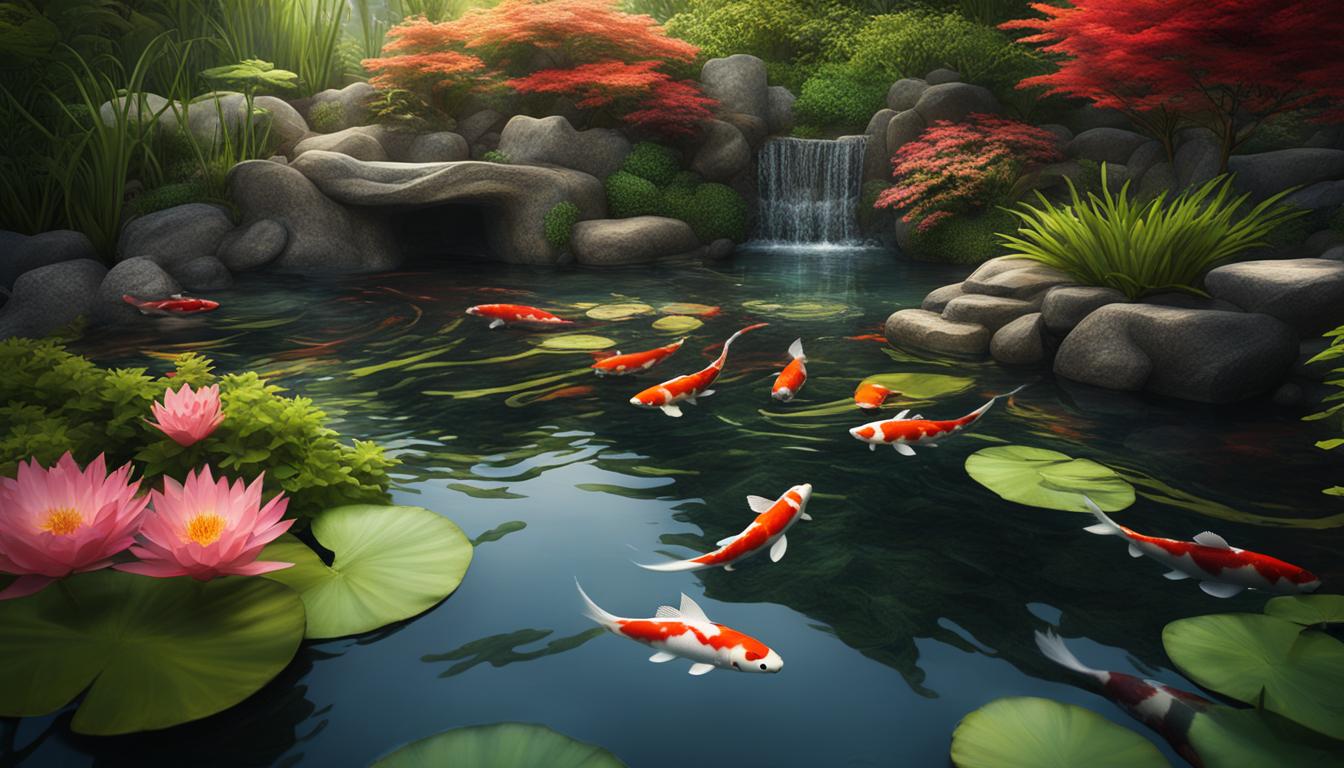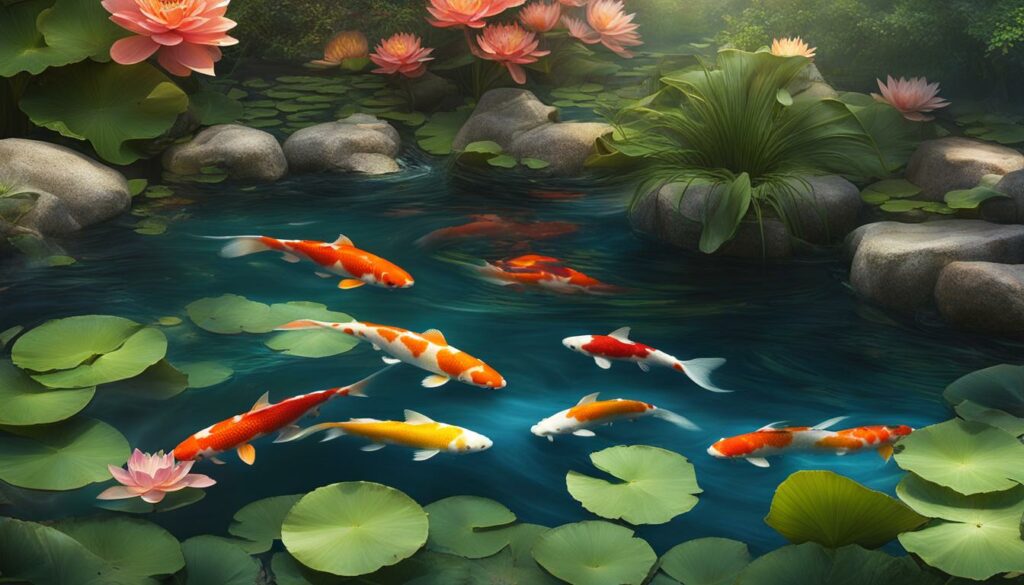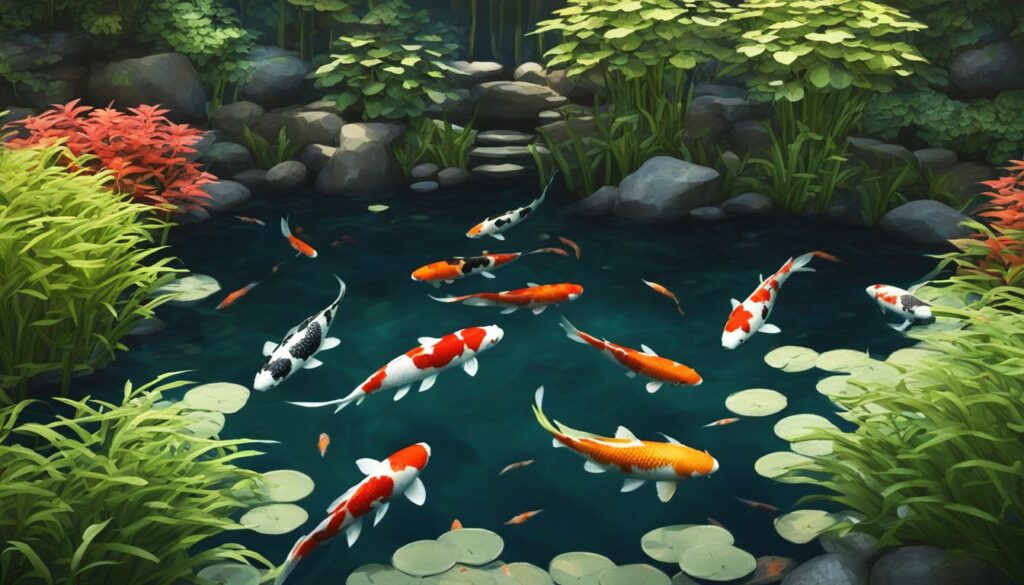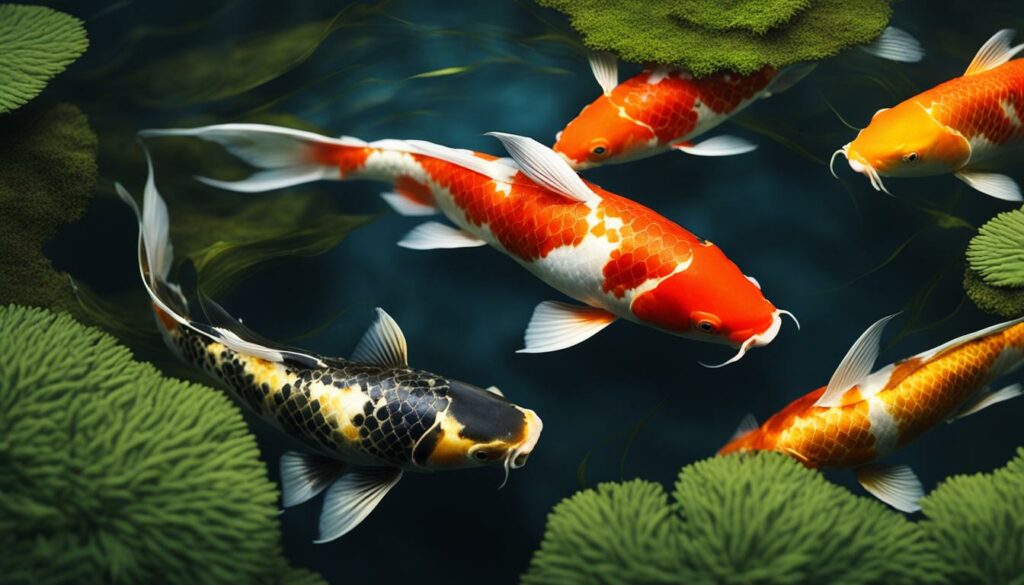
Imagine stepping out into your backyard to be greeted by the serene melody of flowing water and the vibrant dance of koi fish gliding beneath the surface. Koi ponds have transcended their cultural origins to become a cherished centerpiece in garden water features around the world. Integrating a koi pond into your outdoor landscape is not merely about adding water; it's about creating a tranquil outdoor space, a living painting that breathes life into your garden.
As a focal point of landscape design, these intricate water features offer a peaceful retreat and a dynamic ecosystem. From the soft sounds of water to the kinetic energy of the koi, these ponds provide an aesthetic and emotional sanctuary that can elevate any garden into a contemplative haven.
- Discover the aesthetic and emotional benefits of incorporating a koi pond in your garden.
- Understand how koi ponds create a harmonious focal point in landscape design.
- Learn about the cultural significance and the serene ambiance offered by garden koi ponds.
- Recognize the contribution of koi ponds in enhancing the tranquility and beauty of an outdoor space.
- Explore the growing popularity of koi ponds as a feature in home landscaping projects.
Introduction to the Serene World of Koi Ponds
Steeped in the rich cultural heritage of Japan, koi ponds offer much more than mere aesthetics to any garden. They are a symbol of love and friendship; a legacy that has transcended global boundaries to bring a touch of serenity to landscapes around the world. These serene water features are intrinsically designed to house vibrant koi fish, whose elegance and grace are a sight to behold. Beyond their beauty, koi ponds foster a serene ambiance, as the gentle murmur of water interplays with the flamboyant palette of the aquatic life within.

Koi ponds seamlessly blend form with function, serving as a peaceful retreat and a living ecosystem. The allure of these garden features lies not just in their ability to enrich a garden's pond design but also in the profound impact they have on human well-being. The presence of a koi pond has been known to offer stress relief, transforming an ordinary garden space into a tranquil haven where one can commune with nature.
“To sit by a koi pond is to be absorbed into a world where beauty and tranquility reign supreme, and time seems to stand still.”
Adding a koi pond to your property goes beyond mere aesthetic enhancement. It can significantly enhance property value and provide a delightful hobby for nature enthusiasts. The complexities of maintaining a thriving aquatic habitat for aquatic life offer a rewarding experience, as enthusiasts learn the intricacies of ecological balance and koi care.
- Introduction of calming serene water features into a garden setting
- Colorful koi fish contributing to the dynamic natural beauty
- Benefits including stress reduction and potential property value increase
- A gratifying hobby that involves interaction with the natural world
In this article, we journey into the intricacies of koi ponds, understanding their essence in garden design, and unveiling the reasons they have become a cherished addition to outdoor spaces geared towards tranquility and aesthetic appeal.
Essential Elements of Koi Pond Design
Embarking on the journey of creating a captivating koi pond begins with understanding the essential elements that contribute to its beauty and functionality. A well-designed koi pond not only serves as a sanctuary for its inhabitants but also enhances the overall appeal of your landscape. In this section, we'll explore the fundamental aspects of koi pond design that are critical to your project's success. From the ideal location that fosters the delicate balance of light and shelter, to the harmonious integration of natural aesthetics, and the practical considerations of size and depth for healthy aquatic life—each factor plays a pivotal role in the creation of an enchanting garden water feature.
Choosing the Perfect Location for Your Pond
The location of your koi pond can have a profound impact on its health and aesthetic appeal. It's essential to assess the interplay between sun exposure and natural shelter, which will inform not only the growth and vibrancy of aquatic plants but also the well-being of the koi. A spot that receives moderate sunlight with partial shade is usually ideal, as it will prevent overexposure to direct sunlight and excessive algae growth. It is equally important to consider the surrounding environment and adapt the pond's placement to complement your existing landscape design.

Incorporating Natural Aesthetics for Harmony
Blending a koi pond into the natural landscape is an art form that calls for a delicate balance between design and nature. The key lies in choosing elements that contribute to the overall harmony of your garden space. Utilizing naturally occurring materials such as rocks, pebbles, and timber can help in creating an authentic and serene setting. Introducing a variety of aquatic plants not only adds color and life to your pond but also plays an indispensable role in maintaining the ecological balance and supporting the pond filtration system.
Selecting the Ideal Size and Depth
To ensure the health and longevity of your koi as well as their aquatic environment, considering the size and depth of the pond is critical. Ample space is necessary as koi grow and require room to swim freely. The depth of the pond is equally important, as it provides the koi with protection during extreme weather conditions and contributes to a stable and healthy pond ecosystem. Furthermore, adequate depth allows for efficient pond filtration and clearer water, which is vital for maintaining a spectacular garden water feature that will be beloved for years to come.
Koi Pond Filtration Systems
Ensuring the pristine clarity of water and the health of your koi fish, pond filtration is a crucial component of any well-maintained fish pond. There are two primary types of filtration systems central to the upkeep of water features: mechanical and biological. Each plays a pivotal role in supporting a vibrant ecosystem that caters to koi fish care.
Mechanical filters are the first line of defense, physically removing debris and sediments from the water. They ensure that the pond remains visually pleasing and prevent the accumulation of organic matter that can decompose and deteriorate water quality. Biological filters, on the other hand, rely on beneficial bacteria to break down harmful ammonia and nitrites from fish waste, providing a natural cleaning process that is essential for a balanced and healthy pond environment.
“A well-designed filtration system is the heart of every thriving koi pond. It not only maintains water clarity and quality but also ensures that your koi live in a safe and conducive habitat.”
When selecting a pond filtration system, consider the following:
- The size and volume of your pond
- The amount and type of fish and plant life within the ecosystem
- The location of your pond and the amount of natural debris it may encounter
- Your personal maintenance preference and ability
Installation and maintenance are equally important in the care of your filtration system. Regular cleaning, typically on a weekly or bimonthly basis, is necessary to prevent clogging and to ensure that the system functions at optimal levels. Furthermore, during the installation, it is crucial to integrate the system into your pond's design so that it works effectively without disrupting the aesthetic harmony of your water feature.
In conclusion, a well-chosen and properly maintained filtration system not only preserves the beauty of your koi pond but also creates a sustainable environment for your aquatic life. It stands as a testament to the careful balance between nature and technology, providing endurance and ease of care for pond enthusiasts everywhere.
The Role of Aquatic Plants in Koi Ponds
Integrating aquatic plants into a koi pond design not only adds visual splendor but is crucial for sustaining a balanced ecosystem. These verdant water-dwellers play essential roles in oxygen production, nutrient cycling, and serve as natural hideaways for koi, promoting a robust aquatic environment. Understanding the interplay of plants and koi is key to successful pond maintenance and ecological health.
Types of Beneficial Aquatic Plants
Choosing the right variety of aquatic plants is vital for a thriving koi pond. Submerged plants, such as Anacharis, actively oxygenate the water and assist in the control of algae. Floating plants, like Water Lilies, provide shade, reducing sunlight exposure which can warm water to harmful levels for koi. Marginal plants, including Cattails and Iris, naturalize the pond edges and contribute to nutrient absorption, minimizing the risk of water eutrophication.
Creating a Balanced Ecosystem
A harmonious pond environment requires more than just aesthetically pleasing design; it's about delicate equilibrium between the living organisms. Aquatic plants are natural biofilters, purifying the water by breaking down harmful substances and serving as a food source for beneficial bacteria. These microorganisms in turn break down koi waste, turning it into useful nutrients that further feed the plant life—a classic example of a self-sustaining, balanced ecosystem.

Maintenance Tips for Aquatic Flora
Regular koi pond maintenance ensures that your aquatic plants remain healthy and effective in their roles. Here are a few tips:
- Prune regularly: Trim dead leaves and excessive growth to prevent decay and nutrient overload in the water.
- Control plant spread: Keep fast-growing species in pots or contained areas to prevent them from overtaking the pond.
- Monitor water parameters: Check pH levels, temperature, and nutrient levels to ensure plants and koi have optimal conditions.
- Seasonal care: Prepare plants for winter dormancy and rejuvenate them for spring to sustain their contribution to pond health year-round.
Caring for the aquatic flora within your koi pond is a fulfilling endeavor that elevates the quality of life for your fish while enhancing the overall charm and balance of your garden's aquatic showcase.
Conclusion
The journey through the enchanting realm of koi ponds has revealed the myriad ways in which these serene garden spaces can enrich our lives. We've delved into the essentials of koi pond maintenance, explored the interplay of aquatic life and landscape design, and highlighted the benefits that a tranquil water feature can offer to any outdoor area. The integration of each component—from the strategic positioning of the pond to the selection of vibrant aquatic plants—serves as a testament to the beauty and balance nature can achieve.
As we have seen, the creation of a koi pond transcends simple aesthetics; it is an investment in serenity. Whether through the soothing sounds of water or the graceful dance of koi beneath the surface, these features act as a living tableau within your garden. It demands attention to detail in every aspect, from the early stages of design to the ongoing commitment to maintenance. However, the result is a serene garden space that is dynamic, life-affirming, and soothing to the spirit.
As this guide concludes, it leaves you equipped not only with practical knowledge but also with inspiration. Whether you are contemplating the initial layout of your pond or seeking ways to optimize the health and happiness of your koi, remember that your efforts lead to a rewarding journey. The cultivation of a koi pond is a creative and calming endeavor—one that beckons you to begin with confidence and anticipation for the tranquility that awaits.








